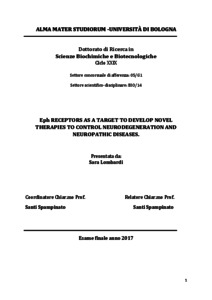Lombardi, Sara
(2017)
Eph Receptors as a Target to Develop Novel Therapies to Control Neurodegeneration and Neuropathic Diseases, [Dissertation thesis], Alma Mater Studiorum Università di Bologna.
Dottorato di ricerca in
Scienze biochimiche e biotecnologiche, 29 Ciclo. DOI 10.6092/unibo/amsdottorato/8087.
Documenti full-text disponibili:
![[img]](http://amsdottorato.unibo.it/8087/1.hassmallThumbnailVersion/Lombardi_Sara_tesi.pdf)  Anteprima |
|
Documento PDF (English)
- Richiede un lettore di PDF come Xpdf o Adobe Acrobat Reader
Disponibile con Licenza: Salvo eventuali più ampie autorizzazioni dell'autore, la tesi può essere liberamente consultata e può essere effettuato il salvataggio e la stampa di una copia per fini strettamente personali di studio, di ricerca e di insegnamento, con espresso divieto di qualunque utilizzo direttamente o indirettamente commerciale. Ogni altro diritto sul materiale è riservato.
Download (3MB)
| Anteprima
|
Abstract
Eph receptors and ephrins enable reciprocal communications between different cell types in the developing and adult nervous system playing critical roles in axonal guidance, neuronal progenitor positioning, synapse formation and neuronal plasticity. Dysfunction of Ephs-ephrins system is involved in neurological disorders.
Class-B of Ephs-ephrins has been implicated in the induction and persistence of pain. The activation of spinal EphB1 receptor by ephrinB1-Fc contributes to the development and morphine tolerance in bone cancer pain. Moreover, EphB1 receptor is up-regulated in the spinal dorsal horn following an escalating morphine treatment whereas spinal administration of EphB2-Fc, which block EphB1, reverses bone cancer pain in animal models.
Characterization of EphB1 molecular mechanisms involved in neuropathic pain will be useful to develop novel EphB1 antagonist, capable to modulate these signaling pathways. To this aim, I investigated any functional cross-talk between MOR and EphB1 in different cell models co-expressing both receptors.
EphB1 agonist receptor (ephrinB1-Fc) or the MOR agonist morphine determine a time-dependent increase p42/44 phosphorylation when these ligands are administered as single agents whereas their co-administration occluded p42/p44 activation. Such cross-talk, as well as EphB1 and MOR expression, are modified in neuronal cells subjected to differentiation or to exposure to the pro-inflammatory agent TNF-α; thus, suggesting a differential role played by the functional interaction between EphB1 and MOR depending on the physiological state of neuronal cells.
Some members of EphA receptors modulate adult neuronal functions. EphA4, expressed in the hippocampus and cortex, regulates neuronal plasticity. However, aberrant EphA4 levels promote neurodegeneration. I set-up a cell-based assay suitable to test peptide and small molecules in order to develop inhibitors with increased potency and improved pharmacological properties.
Efforts to characterize and optimize peptides and small molecules that target specific Eph receptors and ephrins, could provide useful leads for innovative pharmacological approaches to treat neurological diseases.
Abstract
Eph receptors and ephrins enable reciprocal communications between different cell types in the developing and adult nervous system playing critical roles in axonal guidance, neuronal progenitor positioning, synapse formation and neuronal plasticity. Dysfunction of Ephs-ephrins system is involved in neurological disorders.
Class-B of Ephs-ephrins has been implicated in the induction and persistence of pain. The activation of spinal EphB1 receptor by ephrinB1-Fc contributes to the development and morphine tolerance in bone cancer pain. Moreover, EphB1 receptor is up-regulated in the spinal dorsal horn following an escalating morphine treatment whereas spinal administration of EphB2-Fc, which block EphB1, reverses bone cancer pain in animal models.
Characterization of EphB1 molecular mechanisms involved in neuropathic pain will be useful to develop novel EphB1 antagonist, capable to modulate these signaling pathways. To this aim, I investigated any functional cross-talk between MOR and EphB1 in different cell models co-expressing both receptors.
EphB1 agonist receptor (ephrinB1-Fc) or the MOR agonist morphine determine a time-dependent increase p42/44 phosphorylation when these ligands are administered as single agents whereas their co-administration occluded p42/p44 activation. Such cross-talk, as well as EphB1 and MOR expression, are modified in neuronal cells subjected to differentiation or to exposure to the pro-inflammatory agent TNF-α; thus, suggesting a differential role played by the functional interaction between EphB1 and MOR depending on the physiological state of neuronal cells.
Some members of EphA receptors modulate adult neuronal functions. EphA4, expressed in the hippocampus and cortex, regulates neuronal plasticity. However, aberrant EphA4 levels promote neurodegeneration. I set-up a cell-based assay suitable to test peptide and small molecules in order to develop inhibitors with increased potency and improved pharmacological properties.
Efforts to characterize and optimize peptides and small molecules that target specific Eph receptors and ephrins, could provide useful leads for innovative pharmacological approaches to treat neurological diseases.
Tipologia del documento
Tesi di dottorato
Autore
Lombardi, Sara
Supervisore
Dottorato di ricerca
Ciclo
29
Coordinatore
Settore disciplinare
Settore concorsuale
Parole chiave
Eph receptors and ephrins; mu-opioid receptor; neurodegeneration; neuropathic pain.
URN:NBN
DOI
10.6092/unibo/amsdottorato/8087
Data di discussione
19 Aprile 2017
URI
Altri metadati
Tipologia del documento
Tesi di dottorato
Autore
Lombardi, Sara
Supervisore
Dottorato di ricerca
Ciclo
29
Coordinatore
Settore disciplinare
Settore concorsuale
Parole chiave
Eph receptors and ephrins; mu-opioid receptor; neurodegeneration; neuropathic pain.
URN:NBN
DOI
10.6092/unibo/amsdottorato/8087
Data di discussione
19 Aprile 2017
URI
Statistica sui download
Gestione del documento:


 Login
Login
